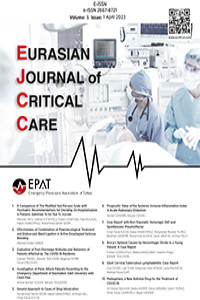Abstract
References
- Organization WH. Suicide in the world: global health estimates. World Health Organization, 2019.
- Mgaya E, Kazaura MR, OutwaterA, Kinabo L. Suicide in the Dar es Salaam region, Tanzania, 2005. Journal of forensic and legal medicine. 2008;15(3):172-6.
- Coskun M, Zoroglu S, Ghaziuddin N. Suicide rates among Turkish and American youth: a cross-cultural comparison. Archives of suicide research. 2012;16(1):59-72.
- Demirel B, Akar T, SayinA, Candansayar S, Leenaars AA. Farewell to the world: Suicide notes from Turkey. Suicide and Life-Threatening Behavior. 2008;38(1):122-7.
- Hockberger RS, Rothstein RJ. Assessment of suicide potential by nonpsychiatrists using the SAD PERSONS score. The Journal of emergency medicine. 1988;6(2):99-107.
- Turecki G, Brent DA, Gunnell D, O’Connor RC, Oquendo MA, Pirkis J, et al. Suicide and suicide risk. Nature reviews Disease primers. 2019;5(1):1-22.
- Windfuhr K, While D, Kapur N, Ashcroft DM, Kontopantelis E, Carr MJ, et al. Suicide risk linked with clinical consultation frequency, psychiatric diagnoses and psychotropic medication prescribing in a national study of primary-care patients. Psychological medicine. 2016;46(16):3407-17.
- Nishi M, Miyake H, Okamoto H, Goto Y, Sakai T. Relationship Between Suicide and Holidays. Journal of Epidemiology. 2000;10(5):317-20.
- Brådvik L. The occurrence of suicide in severe depression related to the months of the year and the days of the week. European archives of psychiatry and clinical neuroscience. 2002;252(1):28-32.
- Patterson WM, Dohn HH, Bird J, Patterson GA. Evaluation of suicidal patients: the SAD PERSONS scale. Psychosomatics. 1983;24(4):343-9.
- Katz C, Randall JR, Sareen J, Chateau D, Walld R, Leslie WD, et al. Predicting suicide with the SAD PERSONS scale. Depression and anxiety. 2017;34(9):809-16.
- Cochrane-Brink KA, Lofchy JS, Sakinofsky I. Clinical rating scales in suicide risk assessment. General hospital psychiatry. 2000;22(6):445-52.
A Comparison of The Modified Sad Persons Scale with Psychiatric Recommendations for Deciding On Hospitalization In Patients Admitted To Ed Due To Suicide
Abstract
Objective: There are scales to decide hospitalization or follow up in patients presenting to the emergency department after suicide attempt. Modified SAD PERSONS scale (MSPS) is the scaling system for adult suicide generated using the initials of 10 major demographic risk factor in the literature. The aim of our study is to investigate the reliability of the MSPS patients who are evaluated in the emergency department after suicide attempt for deciding admission or discharging of patients in our population.
Material-Method: Patients admitted to our emergency department with suicide attempts was evaluated by MSPS. All patients were evaluated by MSPS also consulted to a psychiatrist concurrently. MSPS suggestions are compared with psychiatry decisions. All data were inputted into SPSS analyzed statistically.
Results: There were 205 patients totaly and 147of them were female. Psychiatrics decide hospitalization for 95% of patients MSPS score higher than 8. 131 patients MSPS score less than 6 are evaluated by psyhiatrics and 5 (3.8%) of them were decided for hospitalization. MSPS has sensitivity 90%, specificity 84%, positive predictive value 67%, negative predictive value 96% for deciding hospitalization when compared with psychiatric evaluation.
Conclusion: Giving the decision of discharging or hospitalization of patients presenting in the emergency department after suicide attempt is a serious dilemmas for doctors working in the emergency department. There is a need for objective evaluation of such patients of in the emergency department. Although MSPS does not meet all of the requirements but can be used in the emergency department.
References
- Organization WH. Suicide in the world: global health estimates. World Health Organization, 2019.
- Mgaya E, Kazaura MR, OutwaterA, Kinabo L. Suicide in the Dar es Salaam region, Tanzania, 2005. Journal of forensic and legal medicine. 2008;15(3):172-6.
- Coskun M, Zoroglu S, Ghaziuddin N. Suicide rates among Turkish and American youth: a cross-cultural comparison. Archives of suicide research. 2012;16(1):59-72.
- Demirel B, Akar T, SayinA, Candansayar S, Leenaars AA. Farewell to the world: Suicide notes from Turkey. Suicide and Life-Threatening Behavior. 2008;38(1):122-7.
- Hockberger RS, Rothstein RJ. Assessment of suicide potential by nonpsychiatrists using the SAD PERSONS score. The Journal of emergency medicine. 1988;6(2):99-107.
- Turecki G, Brent DA, Gunnell D, O’Connor RC, Oquendo MA, Pirkis J, et al. Suicide and suicide risk. Nature reviews Disease primers. 2019;5(1):1-22.
- Windfuhr K, While D, Kapur N, Ashcroft DM, Kontopantelis E, Carr MJ, et al. Suicide risk linked with clinical consultation frequency, psychiatric diagnoses and psychotropic medication prescribing in a national study of primary-care patients. Psychological medicine. 2016;46(16):3407-17.
- Nishi M, Miyake H, Okamoto H, Goto Y, Sakai T. Relationship Between Suicide and Holidays. Journal of Epidemiology. 2000;10(5):317-20.
- Brådvik L. The occurrence of suicide in severe depression related to the months of the year and the days of the week. European archives of psychiatry and clinical neuroscience. 2002;252(1):28-32.
- Patterson WM, Dohn HH, Bird J, Patterson GA. Evaluation of suicidal patients: the SAD PERSONS scale. Psychosomatics. 1983;24(4):343-9.
- Katz C, Randall JR, Sareen J, Chateau D, Walld R, Leslie WD, et al. Predicting suicide with the SAD PERSONS scale. Depression and anxiety. 2017;34(9):809-16.
- Cochrane-Brink KA, Lofchy JS, Sakinofsky I. Clinical rating scales in suicide risk assessment. General hospital psychiatry. 2000;22(6):445-52.
Details
| Primary Language | English |
|---|---|
| Subjects | Emergency Medicine |
| Journal Section | Original Articles |
| Authors | |
| Publication Date | April 30, 2023 |
| Submission Date | November 28, 2022 |
| Acceptance Date | March 22, 2023 |
| Published in Issue | Year 2023 Volume: 5 Issue: 1 |


